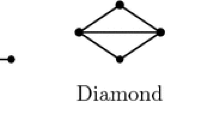Abstract
A domatic (resp. total domatic) k-coloring of a graph G is an assignment of k colors to the vertices of G such that each vertex contains vertices of all k colors in its closed neighborhood (resp. open neighborhood). The domatic (resp. total domatic) number of G, denoted d(G) (resp. \(d_t (G)\)), is the maximum k for which G has a domatic (resp. total domatic) k-coloring. In this paper, we show that for two non-trivial graphs G and H, the domatic and total domatic numbers of their Cartesian product \(G \mathbin \square H\) is bounded above by \(\max \{|V(G)|, |V(H)|\}\) and below by \(\max \{d(G), d(H)\}\). Both these bounds are tight for an infinite family of graphs. Further, we show that if H is bipartite, then \(d_t(G \mathbin \square H)\) is bounded below by \(2\min \{d_t(G),d_t(H)\}\) and \(d(G \mathbin \square H)\) is bounded below by \(2\min \{d(G),d_t(H)\}\). As a consequences, we get new bounds for the domatic and total domatic number of hypercubes and Hamming graphs of certain dimensions, and exact values for some n-dimensional tori which turns out to be a generalization of a result due to Gravier from 2002.
Similar content being viewed by others
Data Availability
Not applicable.
References
Akbari, S., Motiei, M., Mozaffari, S., Yazdanbod, S.: Cubic graphs with total domatic number at least two. Discuss. Math. Graph Theory 38, 75–82 (2018)
Chen, B., Kim, J.H., Tait, M., Verstraete, J.: On coupon colorings of graphs. Discrete Appl. Math. 193, 94–101 (2015)
Cockayne, E.J., Dawes, R.M., Hedetniemi, S.T.: Total domination in graphs. Networks 10, 211–219 (1980)
Cockayne, E.J., Hedetniemi, S.T.: Towards a theory of domination in graphs. Networks 7, 247–261 (1977)
Francis, P., Illickan, A.M., Jose, L.M., Rajendraprasad, D.: Disjoint total dominating sets in near-triangulations, arXiv preprint arXiv:2205.06464 (2022)
Goddard, W., Henning, M.A.: Thoroughly dispersed colorings. J. Graph Theory 88, 174–191 (2018)
Gravier, S.: Total domination number of grid graphs. Discrete Appl. Math. 121, 119–128 (2002)
Gravier, S., Mollard, M., Payan, C.: Variations on tilings in the Manhattan metric. Geom. Dedicata 76, 265–273 (1999)
Havel, I.: Domination in \(n\)-cubes with diagonals. Math. Slovaca 48, 105–115 (1998)
Henning, M.A.: A survey of selected recent results on total domination in graphs. Discrete Math. 309, 32–63 (2009)
Henning, M.A., Yeo, A.: Total domination in graphs. Springer (2013)
Klavžar, S., Seifter, N.: Dominating Cartesian products of cycles. Discrete Appl. Math. 59, 129–136 (1995)
Koivisto, M., Laakkonen, P., Lauri, J.: NP-completeness results for partitioning a graph into total dominating sets. Theor. Comput. Sci. 818, 22–31 (2020)
Nagy, Z.L.: Coupon-coloring and total domination in Hamiltonian planar triangulations. Graphs Combin. 34, 1385–1394 (2018)
Wee, G.J.M.: Improved sphere bounds on the covering radius of codes. IEEE Trans. Inform. Theory 34, 237–245 (1988)
Woldar, A.J., Rainbow graphs, Codes and designs (Columbus, OH, 2000), Ohio State Univ. Math. Res. Inst. Publ., vol. 10, de Gruyter. Berlin, 313–322 (2002)
Zelinka, B.: Domatically ciritical graphs. Czechoslov. Math. J. 30, 486–489 (1980)
Zelinka, B.: Domatic numbers of cube graphs. Math. Slovaca 32, 117–119 (1982)
Zelinka, B.: Regular totally domatically full graphs. Discrete Math. 86, 71–79 (1990)
Zelinka, B.: Total domatic number and degrees of vertices of a graph. Math. Slovaca 39, 7–11 (1989)
Funding
Not applicable.
Author information
Authors and Affiliations
Corresponding author
Ethics declarations
Conflict of interest
The authors have no relevant financial or non-financial interests to disclose.
Additional information
Communicated by Ismael G. Yero.
Publisher's Note
Springer Nature remains neutral with regard to jurisdictional claims in published maps and institutional affiliations.
P. Francis: Part of this work was done as a post-doctoral fellow at Indian Institute of Technology Palakkad.
Rights and permissions
Springer Nature or its licensor (e.g. a society or other partner) holds exclusive rights to this article under a publishing agreement with the author(s) or other rightsholder(s); author self-archiving of the accepted manuscript version of this article is solely governed by the terms of such publishing agreement and applicable law.
About this article
Cite this article
Francis, P., Rajendraprasad, D. On Domatic and Total Domatic Numbers of Cartesian Products of Graphs. Bull. Malays. Math. Sci. Soc. 46, 114 (2023). https://doi.org/10.1007/s40840-023-01504-3
Received:
Revised:
Accepted:
Published:
DOI: https://doi.org/10.1007/s40840-023-01504-3




